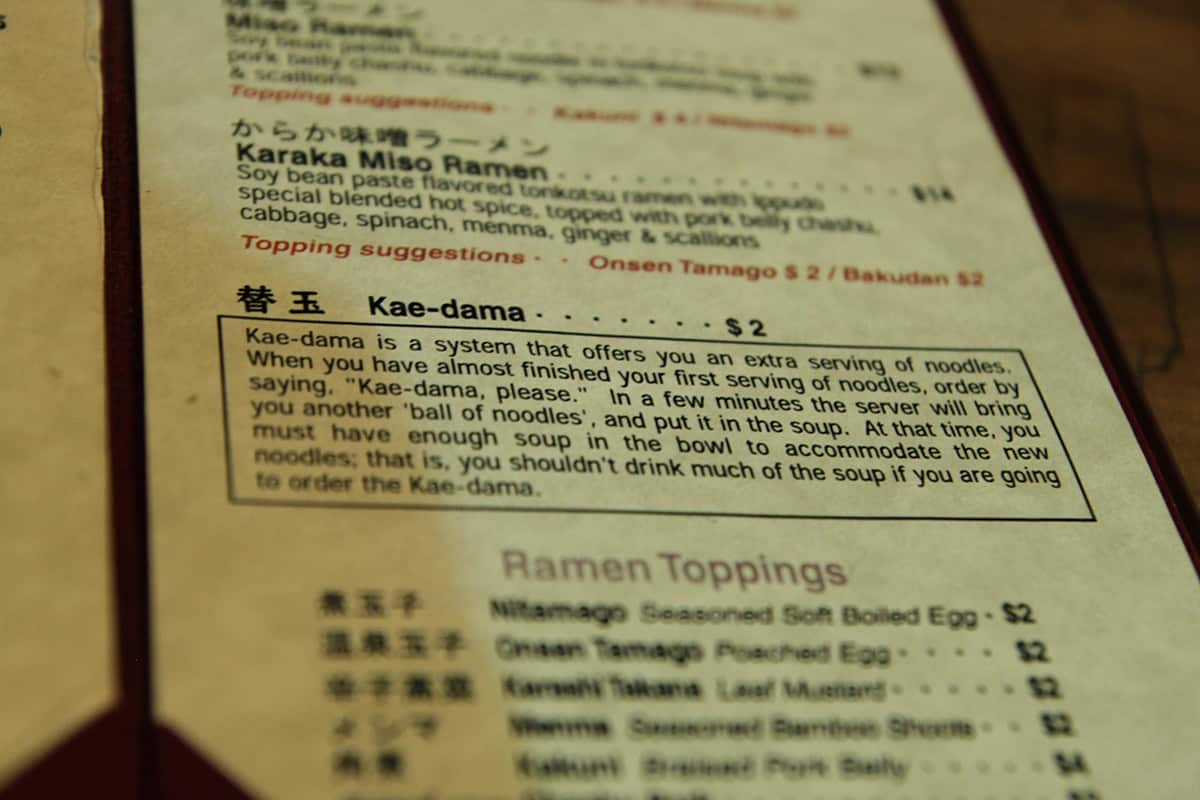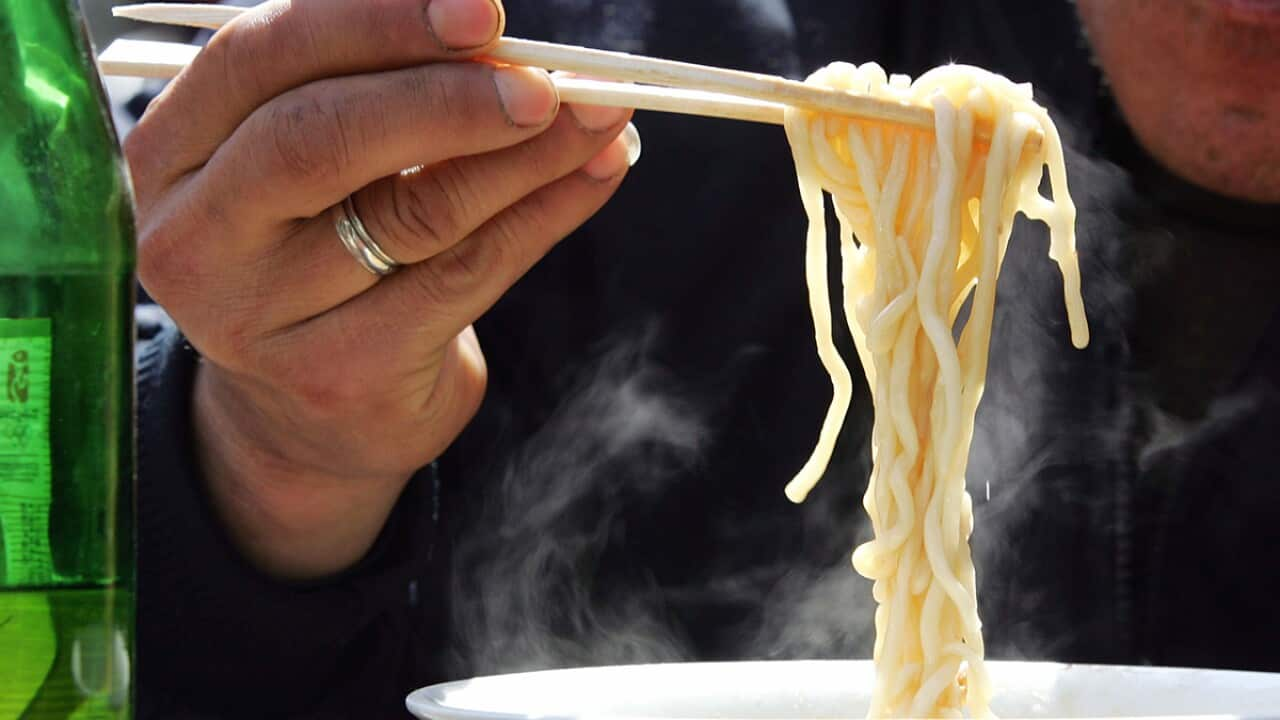Carb-lovers, rejoice. If you’re the kind of person who finishes all their noodles before they’ve even had a sip of broth, there’s a word you need to know.
It’s ‘kae-dama’. Technically, it means double, but in the context of a ramen shop, it means a second serve of noodles.
The practice began in Fukuoka, in the south-west of Japan. The city is famous for Hakata ramen, featuring a tonkotsu broth and ‘Chikuho’ noodles, which are thin and straight. A combination of the ramen serving sizes in Fukuoka traditionally being smaller and these noodles being particularly absorbent led to a dilemma.
The noodles actually expand in your soup, soaking up the broth. Cram too many into the bowl, and you’ll end up with swollen noodles and not enough soup – plus, it’s cold by the time you reach the bottom.
“The system of kae-dama solved this problem. Kae-dama is Hakata’s unique way of enjoying more noodles in one ramen serving,” states a guide to kae-dama by Fukuoka’s famous ramen chain, Ichiran.
In Fukuoka, an extra serve of noodles will usually set you back up to 100 yen (about $1.30), but some shops offer a free first refill.
Sydney’s Ramen Ikkyu, Melbourne’s Ikkoryu Fukuoka, and Brisbane’s Hakataya Ramen all offer one free noodle refill with their ramen. Many other ramen restaurants across Australia will offer extra noodles for a minimal fee, between $1 and $2.
The plain noodles arrive freshly cooked in a bowl for you to tip into your remaining broth. It’s best to order while you’ve still got about half your soup left, as you won’t get any extra broth. Melbourne restaurant Kokoro Ramen likes to teach its customers how to eat and order ramen, and kae-dama is all part of the experience. Owner Zabad Ngu says “preferably, you’d like to order kae-dama while your broth is still hot. Tonkotsu soup is very strong in flavour, so you tend to slurp up the noodles first.”
Melbourne restaurant Kokoro Ramen likes to teach its customers how to eat and order ramen, and kae-dama is all part of the experience. Owner Zabad Ngu says “preferably, you’d like to order kae-dama while your broth is still hot. Tonkotsu soup is very strong in flavour, so you tend to slurp up the noodles first.”

Kae-dama: a "double" serve. Photograph: Joanne Wan via Flickr. Source: Flickr
“Sometimes I’ll know I want an extra serve from the start, but I won’t order it at first or it will get cold. Sometimes, even that’s not enough.” he says. Zabad explains that a bowl of broth is perfect for two noodle helpings, though there is no limit to the number of times you can order a refill, at $2 a pop.
In Japan it’s only ramen that comes with the option for a noodle refill, not soba, udon, or cold noodles. Some restaurants that serve several types of ramen will only offer a refill with Hakata ramen, as that is more traditional, but the practice has definitely caught on – and it’s not just limited to ramen shops.
A sign in the window of a new stall in Sydney’s subterranean Dixon House food court caught the attention of hungry customers some months back: "free noodles refill".
Face2Face Noodles specialises in food from Chongqing, China. While you can find noodle refills in some parts of China, owner Tim Wang says they aren’t traditional in his home city of Chongqing. There, spicy noodles come in a 100g serve, but he wanted to give his customers extra value.
“It’s not fair to pay $9.50 for a bowl of soup and leave half full,” says Tim.
The wheat noodles are made fresh each day, in front of customers, and Tim says that’s why he can afford to give extra to customers who ask for it.
On my first visit, extra noodles were offered (and accepted) up front, along with an invitation to come back for more if I was still hungry. I’m told Westerners suffer the distinct disadvantage of not being to eat noodles as quickly, losing precious seconds before your brain catches up to your stomach.
So exactly how many refills will Face2Face honour before they cut you off?
“I have had a few coming back for 5 or 6 refills, and I gave it to them,” says Tim. “One Chinese customer actually came and brought his own giant bowl to the food court, and asked me to fill it up,” he laughs.
“Between 30 to 40 per cent ask for refill. To me, that means the taste was good – so I am happy when people come back.”
Throughout August, SBS Food is celebrating Asia's love of the noodle. Oodles of Noodles include delicious new recipes, stories and tips for buying, cooking and storing noodles. Find out more here or check out our interactive map, featuring 31 new recipes.
we love noodle soup

Ramencyclopaedia: On broth, noodles and becoming a ramen master



